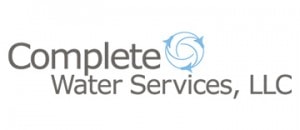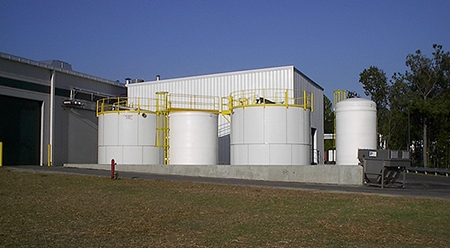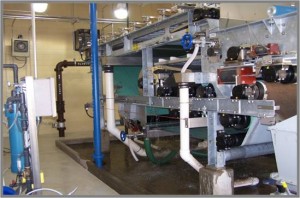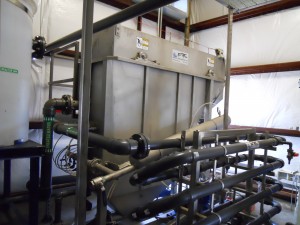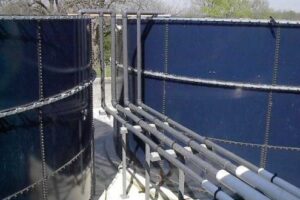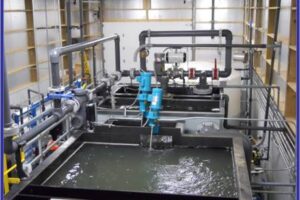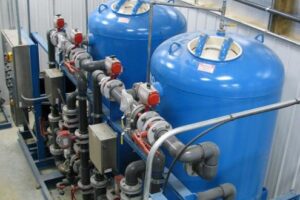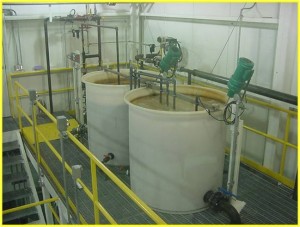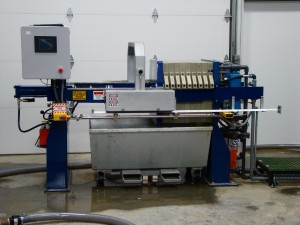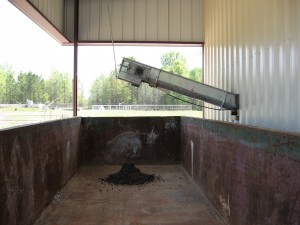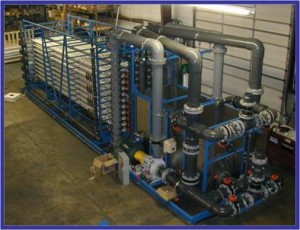Wastewater – Industrial Metal Finishing
The wave of globalization in manufacturing has led to new manufacturing processes being implemented in locales that do not have previous experience with industrial wastewater discharges, much less with the impacts that the contaminants, which may be present in these discharges, have on human health and the environment.
Metal finishing is a prime example of the type of industry that has expanded on a worldwide basis. This article details the impacts that metal finishing operations may have on the local water supplies and the types of treatment systems options available to make these discharges safe for the environment.
Metal finishing industries cover a broad range of processes including electroplating, electroless plating, anodizing, coatings, etching and chemical milling, and printed circuit board manufacturing. Contaminants and characteristics of wastewater from these types of operations include:
- pH excursions caused by acid and caustic cleaning, and plating bath carryover
- High levels of heavy metals used in plating operations
- High levels of phosphorus resulting from phosphate coating operations
- High levels of cyanide (cyanides are used to improve the plating process)
- High levels of toxic organic compounds that are associated with oily wastewater and solvents used for cleaning, etc.
Even though metal finishing processes may be the same type, wastewater from an individual facility is unique to that specific facility. Each of the contaminants or characteristics stated above has a treatment process, which when combined, results in a treatment train that is designed specifically for that particular wastewater.
Equalization
Equalization (EQ) is a means of buffering or equalizing the characteristics of wastewater prior to entering the wastewater treatment system. Industrial waste streams vary considerably in both level of contaminants (pH, total suspended solids, etc.) and flow rates. To minimize the impact of these fluctuations on downstream processes, equalization should be considered. Benefits of EQ include:
- Substantially reduced chemical costs, especially associated with pH fluctuations, and coagulants and flocculants required for solids removal.
- Smaller downstream treatment components. Downstream treatment components do not have to be sized to handle instantaneous flow peaks.
- Ease of operations. EQ substantially reduces process adjustments required in day-to-day operations.
Most EQ systems consist of a tank that is mixed or aerated to keep solids from settling to the bottom. Depending on the waste stream, aeration may be required to keep the waste from becoming odorous or assist in oxidizing some metals. A good Rule-of-Thumb for EQ systems is to be capable of holding one day of peak wastewater flow. If the waste stream has large settleable solids, screening may be required prior to equalization. Also, considerations must be made with regard to the type of coating on the tank, especially if the waste stream is very acidic or basic.
Neutralization and pH Adjustment
pH is a measure of the degree of acidity and basicity of a solution. More exactly, it is the measurement (negative logarithm) of the hydrogen ion concentration [H+]. The scale ranges from 0 (most acidic) to 14 (most basic). The term pH refers to “pondus hydrogenii” or power of hydrogen.
Because pH is simply another means of referring to the hydrogen ion concentration, acidic and basic solutions can be distinguished on the basis of pH values:
pH < 7 Acidic solution pH = 7 Neutral solution pH > 7 Basic solution
Neutralization of wastewater that is highly acidic (low pH) or highly basic (high pH) is required for discharge to municipal sewer systems or to rivers and streams. The most common allowable pH range for discharge is generally 6 to 9 standard units (S.U.) but can be 5.0 to 11.0 depending on the source of discharge. There are four main reasons to control the pH in wastewater:
- Protect human health and the environment; fish and other living organisms in rivers and streams.
- Protect the wastewater infrastructure from corrosion, especially from acidic wastewater.
- Protect the biological treatment process incorporated at most municipal treatment systems.
- Many pretreatment processes require that the pH be adjusted as an initial step in treatment so that the processes work correctly, such as:
- Coagulation and flocculation processes for the removal of oil and grease, phosphates, and suspended solids.
- Precipitation of metals in the metals removal treatment processes.
Wastewater with a low pH is generally neutralized using sodium hydroxide (NaOH), lime (CaO), magnesium hydroxide (Mg(OH)2), or calcium hydroxide (Ca(OH)2). Wastewater with a high pH is generally neutralized with sulfuric acid (H2SO4), hydrochloric acid (HCl), or carbon dioxide (CO2). The most common chemicals used are H2SO4 and NaOH.
Neutralization can be accomplished by batch treatment or continuous flow processes. Batch treatment is usually for lower flow volumes.
Most systems are continuous flow type systems consisting of one or two neutralization tanks, depending on the flow rate and magnitude of pH swings. With some systems, the pH must be raised or lowered for other removal processes to function properly, and then the pH adjusted back prior to discharge.
Chrome Reduction
Hexavalent chromium (Cr6+) is a form of chromium that is toxic to humans and to the microorganisms in biological treatment plants (i.e. municipal sewage plants). It cannot be precipitated by conventional treatment processes; therefore, it must be converted (reduced) to the less toxic form of trivalent chromium (Cr3+). Trivalent chromium can then be precipitated as chromium hydroxide.
Hexavalent chromium is typically reduced with sodium bisulfite (NaHSO3) at a pH range of 2 to 3 SU using sulfuric acid, with the Oxidation Reduction Potential (ORP) at +250mV or lower. The pH and ORP must be maintained at least for 45 minutes for the reaction to occur. It takes three parts of sodium bisulfite and one part sulfuric acid to one part chromium.
Once the reduction has occurred, the pH should then be raised to 7.5 to 8.5 SU which is the optimum range for the trivalent chromium to precipitate. This conventional chromium reduction treatment process is capable of producing an effluent with less than 0.1 milligram per liter (mg/L) of hexavalent chromium.
Cyanide Destruction
The destruction of cyanide is normally a 2-step process known as alkaline chlorination. Basically, sodium hypochlorite (NaOCl) and caustic (NaOH) are used to break the cyanide bond under alkaline (basic) conditions by first oxidizing cyanide to cyanogen chloride and then to cyanate. The second stage in cyanide destruction is to oxidize the cyanate to carbon dioxide and nitrogen gas.
Stage 1 is the destruction of cyanide that is amenable to chlorination. It is accomplished by the addition of sodium hypochlorite and caustic to raise the pH to 10.5 SU and the ORP to a minimum of 500 mV.
In this stage, the oxidizing agent, sodium hypochlorite, causes the oxidation of cyanide (CN–) to cyanogen chloride (CNCl) and then further oxidized to cyanate (CNO–). The reaction time can be up to 60 minutes during which the conditions of pH at 10.5 SU and ORP ≥ 500mV must be maintained.
In Stage 2, acid is added to lower the pH to 8.5 SU so that the cyanate would oxidize. Lowering the pH allows more chlorine (of the hypochlorite that was added under Stage 1) to be released and the ORP increases. Usually, no additional hypochlorite is required.
The ORP must be maintained above 800 mV and the pH around 8.5 for 30 to 60 minutes for this reaction to occur. In some instances, this reaction can take up to 120 minutes. It takes 7.5 and 8 parts of sodium hypochlorite and sodium hydroxide, respectively, per part of cyanide to perform the oxidization of cyanide.
Destruction of cyanide is very reliable using this method if the system is well maintained. Most problems with this treatment system occur with ill-maintained ORP control systems. Failure of the ORP control is the single largest culprit of treatment system malfunction.
Chelated Metals Treatment
Chelating agents are widely used in industrial applications. Chelates (from the Greek word chela meaning “claw”) complex with metals, thus tying them up and keeping them in solution. This sequestering effect makes chelating agents widely used in cleaning formulations for their ability to dissolve and remove rust, scales, and other debris from metal surfaces. Metal chelates form over a wide range of pH, are highly soluble, and extremely stable.
Some of the most common chelating agents are ethylenediaminetetraacetic acid (EDTA), citrates, nitrilotriacetic acid (NTA), and hydroxyethylenediamine triacetic acid (HEDTA). These compounds form 1:1 complexes with many metal ions, the most common being cadmium (Cd), copper (Cu), lead (Pb), nickel (Ni), zinc (Zn), and mercury (Hg).
Because these compounds are highly soluble and stable, treating wastewater with these complexes can be challenging. In general, the more effective the chelating agent is, the more difficult the metal is to remove. There are generally two methods to remove chelated complexes:
- Removal by ion exchange, nano-filtration or reverse osmosis. These technologies generate concentrates that have to be further treated before properly disposed.
- Breaking the chelate complex is treatment. This is done by either low pH or high pH combined with sulfide technology. These treatment technologies break the complex bonds and free the metal ion for further treatment by precipitation, etc.
Clarification
Clarification (used interchangeably with settling and sedimentation) is the separation of suspended solids from water or wastewater using gravity. Suspended solids include settleable and colloidal solids. Colloidal solids must be chemically treated by the processes of coagulation and flocculation to enhance removal by settling.
The process usually incorporates a rectangular or circular tank (clarifier) that holds the water or wastewater during a set period of time to allow the solids to settle to the bottom. Most clarifiers have a cone or sloped bottom section that concentrates the settled solids. The solids can then be pumped to storage or further treatment.
Some systems include a surface skimmer to remove materials that float and a bottom skimmer to push the sludge to a sludge hopper. These type systems are more common in municipal water and wastewater applications.
Clarifiers used in many industrial applications are rectangular and include inclined plate packs that enhance settling. These plates are usually set at an angle of 45 to 60 degrees. Inclined plate clarifiers work very well for metal finishing wastewater. Wastewater with heavy oils and grease or other viscous materials are not well suited for inclined plate clarifiers as they tend to clog the units. Most inclined plate clarifiers include integral mixing chambers for chemically-enhanced settling.
Dissolved Air Flotation
DAF systems are designed to remove suspended solids along with fat, oils and grease (FOG) from a waste stream by flotation, as opposed to gravity separation. DAF systems work exceptionally well in waste streams that include solids that tend to remain in suspension or float such as chemical and petroleum-based waste streams.
Prior to the DAF, the wastewater must be chemically treated by pH adjustment, coagulation, and flocculation. DAF systems are designed to remove the solid particles formed by the coagulation and flocculation processes by using very small air bubbles that attach to the flocculated particles causing them to float to the surface for removal by skimming. Many DAF systems incorporate a serpentine pipe flocculator for mixing and dosing coagulants and flocculants instead of conventional tanks and mixers.
The tiny bubbles are formed by injecting air under pressure into a wastewater recirculation stream. This recirculation loop uses 10% to 30% of the discharge from the DAF. This air-saturated recirculation stream is returned back to the influent of the DAF for mixing with the incoming, untreated wastewater. When the pressurized water is suddenly released to atmospheric pressure, the air comes out of solution and creates very fine air bubbles (whitewater) that attach and enmesh to the solid particles causing them to float.
DAF systems are equipped with a skimmer for removing the “float” into a sludge hopper. The float is then transferred to the solids handling system for further processing.
Filtration
Filtration is a physical or mechanical operation which separates solids from fluids with the help of a medium called a filter. When the solution is brought in contact with the filter medium, the filter allows the fluid to pass through but retains, at least part, of the solid material. The fluid that passes through the filter is called the filtrate, while the solid material that remains on the filter is called the residue.
There are two main types of filter media: 1) Solid sieve-like media such as filter paper that traps the solid particles; 2) Bed of granular material, like sand, that retains the solid particles as the fluid passes through. The first type of media allows the residue to be recovered intact while the second does not.
Multi-media filtration is a significant improvement over single-media filtration systems such as sand filters. In a conventional sand filter, lighter and finer sand particles are found at the top of the filter bed, and coarser, heavier sand particles remain at the bottom after backwashing. Filtration takes place in the top few inches of the filter bed. For multi-media filters, the coarse media traps large particles and successively smaller particles are trapped in the finer layers of media deeper within the bed. Multi-media filtration permits delivery of high quality filtered water at much faster flow rates, as compared to a conventional sand filter.
Multi-media filters have a granular gravel support bed and the filter media is a natural zeolite. Zeolites are microporous, aluminosilicate minerals commonly used as filter media and commercial adsorbents. Zeolites filter by traditional particle mechanisms like the sand filters and also by their cage-like pore structure. Zeolites are the aluminosilicate members [(AlO2)6(SiO2)30-624H2O] of the family of microporous solids known as “molecular sieves.” The term molecular sieve refers to a particular property of these materials, i.e., the ability to selectively sort molecules based primarily on a size exclusion process. This is due to the molecular dimensions of very regular pore structure. The maximum size of the molecular or ionic species that can enter the pores of a zeolite is controlled by the dimensions of the channels.
Membranes
Membrane technologies represent the cutting edge of filter-based purification technologies. Membranes are used in a wide variety of applications including desalinization, high purity systems and many types of wastewater applications such as membrane bioreactors, oil removal, sulfates and metals removal, and dissolved solids removal, etc.
Common membrane applications include ultrafilters to remove suspended solids and oils (as well as in MBRs); nano filters, to remove suspended solids and some large-molecular-weight dissolved contaminants; and reverse osmosis, for high-purity applications, desalinization and wastewater reuse (dissolved solids).
Membrane systems are available for a variety of flow applications and system sizes; however, in wastewater, many times membranes are applied inappropriately.
The simple principle of a membrane is that it acts as a very specific filter that will let water flow through while suspended solids and other substances are retained. There are two factors that determine the effectiveness of a membrane filtration process: selectivity and productivity. Selectivity is expressed as a parameter called retention or separation factor. Productivity is expressed as a parameter called flux. Selectivity and productivity are membrane-dependent.
Precipitation
Precipitation is the formation of a solid in a solution through a chemical reaction that forms an insoluble compound out of two or more soluble compounds. Precipitation is also the act of separating a solid from a solution. The solid that is formed is called the precipitate, and the liquid solution is called the supernate.
Precipitation is not to be confused with coagulation, although many in the industry use these terms interchangeably. Precipitation is the formation of a solid. Coagulation is the agglomeration of the solid particles.
In most situations, the solid that forms settles out of the solute phase, and settles to the bottom of the solution (though it will float if it is less dense than the solvent or form a suspension). The solid may reach the bottom of a container by means of settling or sedimentation. The separation can be accomplished in a clarifier or settling basin. Floating solids can be removed by enhancing the flotation characteristics and using a DAF unit. Precipitation is a very common process in metals removal.
Solids Handling
The coagulation and flocculation processes chemically convert colloidal solids into larger solids for separation by settling or flotation. This generates an industrial sludge that will require proper handling.
Sludge coming from the processes listed above will be primarily comprised of water. It can be expensive to dispose of wet sludge by weight. To address this, there are several ways to dewater sludge. Two common ways are decanting and pressing.
Sludge dewatering by decanting is the sample principles as discussed above. When the sludge sits in a holding tank, the water rises to the top, is drained off, and it is put back into the treatment system at the head of the works.
A sludge dewatering press, as the name implies, physically squeezes the water phase from the solids phase. This can be done by several methods such as belts and rollers, cloths and plates, screws, etc. A rotary press uses centrifugal force instead of squeezing force to separate the water from the solids. Each of these press types has its proper application.
However, for metal finishing sludges, plate and frame presses are the most common. The plate and frame press is actually a filter that incorporates several individual plates that have porous cloths for filtering the sludge from the water. Sludge is pumped from a holding tank to the press where the water phase passes through the filter cloths while retaining the solids on the cloth within the each plate chamber. A hydraulic system is used to press the plates together. When the press is opened, the solids fall into a receptacle for proper disposal.
Implementing proper pretreatment processes will ensure that industrial metal finishing waste streams contribute minimum impact on human health and the local environment in these new and emerging markets.
I would like to thank Karen J. Niebuhr, PE, Complete Water Services, LLC, for her assistance with this article.
Jim L. Lewis
President
Complete Water Services, LLC
678-355-9270
jlewis@cwaterservices.com
